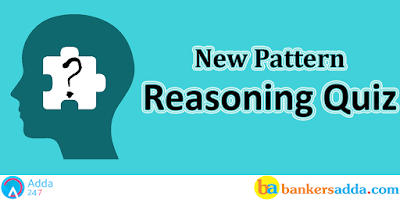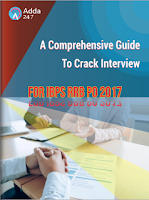Dear Readers,
The reasoning is a game of wits and presence of mind! Yes, it is true and it might seem as the greatest of the challenge after English Section’s surprises but yet this one can easily be dealt with. You just need correct practice and hardwire your brain to quickly make decisions about what to attempt and what to leave. And for same we are providing you questions of Reasoning Question and Answers. Solve these to Practice latest pattern reasoning question for bank exams.
Directions (1-5): Study the following information carefully and answer the given questions:
Twelve persons are sitting in two parallel rows containing six persons each in such a way that there is an equal distance between adjacent persons. In the Row-1 P, Q, R, S, T and U are sitting and all of them are facing south. In the Row-2 A, B, C, D, E and F are sitting and all of them are facing towards north direction but not necessarily in the same order. In the given seating arrangement each member sitting in a row faces another member of the other row.
R sits third to left of U. Only one person sits between R and T. Two persons sit between T and Q. Q does not sit any of the extreme end of the line. B faces S. F sits third to right of B. Immediate neighbour of P faces C. More than two persons sit between C and A. D does not sit adjacent to B.
Q1. Who among the following sits exactly between P and T?
(a) S
(b) R
(c) No one.
(d) U
(e) Q
Q2. Who among the following faces D ?
(a) P
(b) Q
(c) R
(d) S
(e) T
Q3. Who among the following sits second to the left of E?
(a) A
(b) C
(c) No one.
(d) D
(e) F
Q4. How many persons sits between A and D ?
(a) One
(b) Two
(c) Three
(d) Can’t be determined
(e) None of these
Q5. Four of the following five are alike in a certain way based on the given seating arrangement and hence form a group. Which is the one that does not belong to that group ?
(a) P
(b) B
(c) S
(d) D
(e) R
Directions (6 – 10): Study the following information to answer the given questions:
‘lend me money’ is written a ‘ve ka ro’,
‘money for him; is written as ‘se ve di’,
‘for various matters’ is written as ‘ba di la’ and
‘matters to me’ is written as ‘ro ba yo’
6.What is the code for ‘various’?
(a) ba
(b) di
(c) la
(d) yo
(e) Cannot be determined
7.What does the ‘ro’ stand for?
(a) me
(b) matters
(c) money
(d) lend
(e) Either ‘to’ or ‘lend’
8.Which of the following ‘money matters most’?
(a) ve ba yo
(b) ve se ba
(c) ba zi di
(d) ba ka zi
(e) ba fe ve
9.What is the code for ‘lend’?
(a) ve
(b) ka
(c) ro
(d) di
(e) Either ‘di’ or ‘ro’
10.What is the code for ‘to’?
(a) ba
(b) ro
(c) yo
(d) se
(e) Cannot be determined
Directions (11-13): In these questions, relationship between different elements is shown in the statements. The statement is followed by two conclusions.
Give answer (a) If only conclusions I is true.
Give answer (b) If only conclusions II is true.
Give answer (c) If either conclusions I or II is true.
Give answer (d) If neither conclusions I nor II is true.
Give answer (e) If both conclusions I and II are true.
11.Statements: I = P < Q ≤ A > R
Conclusions: (I) A > I (II) R < P
12.Statements: F > O = L ≤ W = S
Conclusions: (I) O ≤ S (II) L < F
13.Statements: S ≥ P = O > T ≤ R = B
Conclusions: (I) B ≥ o (II) S > T
14.How many such pairs of letters are there in the word ‘INDIA’ each of which has as many letters between them in the word as in the English alphabetical series? (In both forward and backward directions)
(a) None
(b) One
(c) Two
(d) Three
(e) More than three
15.If it is possible to make only one meaningful English word with the second, the third, the fourth and the sixth letter of the word CAPITAL, which of the following will be the second letter of that word? If no such word can be formed, give ‘X’ as the answer and if more than one such word can be formed, give ‘Y’ as the answer.
(a)E
(b) A
(c)T
(d)X
(e)Y
You May also like to Read:




 The Hindu Review October 2022: Download ...
The Hindu Review October 2022: Download ...
 SBI SO Salary 2024, Salary Structure, Pe...
SBI SO Salary 2024, Salary Structure, Pe...
 SBI Clerk Previous Year Question Paper P...
SBI Clerk Previous Year Question Paper P...



